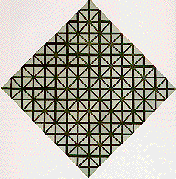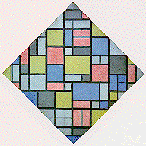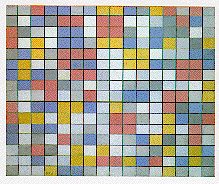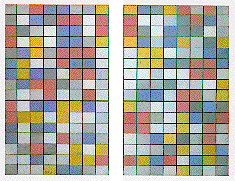 He started with the 64 squares of an 8x8 checkerboard,
oriented diagonally like a diamond lozenge,
or 2-dim Feynman checkerboard.
Then he subdivided (by checkerboard-diagonal lines) the
64 squares into 256 triangles.
64 = 8x8 = number of hexagrams in the I Ching.
256 = 16x16 = dimension of the Clifford algebra Cl(0,8)
Variation of the thickness of the lines makes interesting structure.
ln 1919, Mondrian painted Lozenge with Light Colors and Grey Lines.
He started with the 64 squares of an 8x8 checkerboard,
oriented diagonally like a diamond lozenge,
or 2-dim Feynman checkerboard.
Then he subdivided (by checkerboard-diagonal lines) the
64 squares into 256 triangles.
64 = 8x8 = number of hexagrams in the I Ching.
256 = 16x16 = dimension of the Clifford algebra Cl(0,8)
Variation of the thickness of the lines makes interesting structure.
ln 1919, Mondrian painted Lozenge with Light Colors and Grey Lines.
 The triangles of the 256-triangle lozenge are painted
with the 3 subtractive primary colors - yellow, cyan, magenta -
along with shades of grey for some triangles
as well as for the lines.
The triangles are painted such that
areas of a single color are rectangular.
In this work, some of the lines are so light as to be barely noticeable
(you probably cannot see those lines on this gif).
Karen Wiedman used similar light lines with respect to Penrose tilings
in some of her older paintings.
Later in 1919, Mondrian painted Checkerboard with Light Colors.
The triangles of the 256-triangle lozenge are painted
with the 3 subtractive primary colors - yellow, cyan, magenta -
along with shades of grey for some triangles
as well as for the lines.
The triangles are painted such that
areas of a single color are rectangular.
In this work, some of the lines are so light as to be barely noticeable
(you probably cannot see those lines on this gif).
Karen Wiedman used similar light lines with respect to Penrose tilings
in some of her older paintings.
Later in 1919, Mondrian painted Checkerboard with Light Colors.
 Here he also used only the 3 subtractive primary colors -
- yellow, cyan, magenta -
along with shades of grey.
Instead of 256 triangles, there are 256 = 16x16 rectangles.
The rectangles are NOT square.
The whole painting, if divided in two vertical parts,
Here he also used only the 3 subtractive primary colors -
- yellow, cyan, magenta -
along with shades of grey.
Instead of 256 triangles, there are 256 = 16x16 rectangles.
The rectangles are NOT square.
The whole painting, if divided in two vertical parts,
 is two Golden Rectangles.
is two Golden Rectangles.
References: Mondrian, by John Milner, Phaidon 1992; Jazz Painting, by Susan Delson.